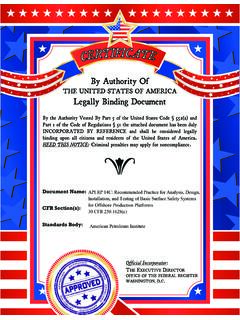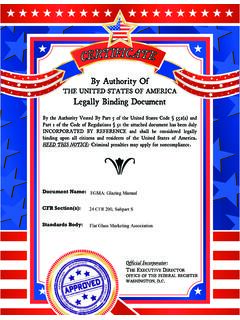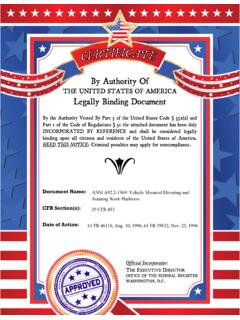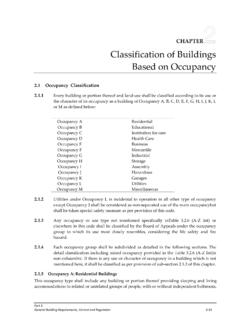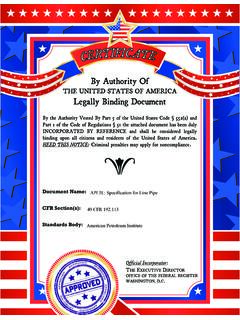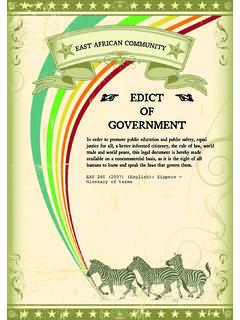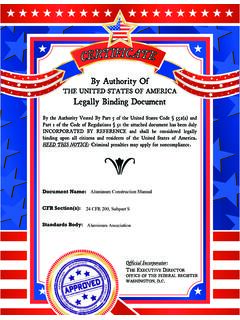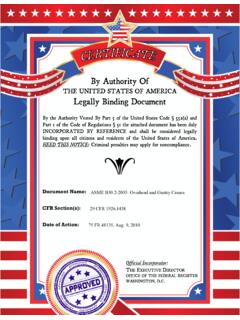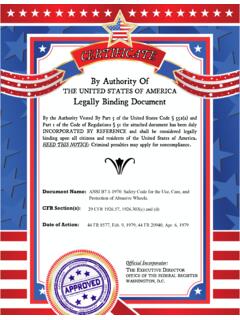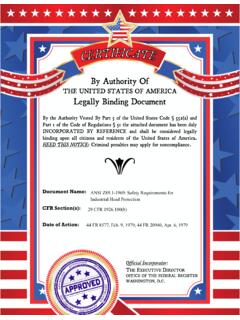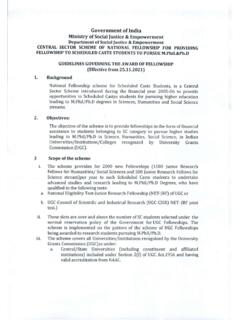Transcription of IS 3414 (1968): Code of Practice for Design and ...
1 Disclosure to Promote the Right To InformationWhereas the Parliament of India has set out to provide a practical regime of right to information for citizens to secure access to information under the control of public authorities, in order to promote transparency and accountability in the working of every public authority, and whereas the attached publication of the Bureau of Indian Standards is of particular interest to the public, particularly disadvantaged communities and those engaged in the pursuit of education and knowledge, the attached public safety standard is made available to promote the timely dissemination of this information in an accurate manner to the public.
2 ! $ ' + - Satyanarayan Gangaram Pitroda Invent a New India Using Knowledge 0 1 ' 5 Jawaharlal Nehru Step Out From the Old to the New 1 + , 1 + Mazdoor Kisan Shakti Sangathan The Right to Information, The Right to Live ! > 0 B Bhart hari N ti atakam Knowledge is such a treasure which cannot be stolen Invent a New India Using Knowledge IS 3414 (1968): Code of Practice for Design andInstallation of Joints in Buildings [CED 13: BuildingConstruction Practices including Painting, Varnishing andAllied Finishing] CODE OF IS : 3414 - 1968 Indian.
3 Standard Practice FOR Design AND INSTALLATION OF JOINTS IN BUILDINGS Building Construction Practices Sectional Committee, BDC 13 Chairman Representing Central Public Works Department Members SHRI B. D. AHUJA National Buildings Organization ( Ministry of Works, Housing & Supply ) SXRI P. C. JAIN ( Alternate) SHRI B. V. APTE Builder s Association of India. Bombay SHR~ K. J. SAPRA ( Ahrnete ) CHIEF ARCHITECT Central Public Works Department ( Architectural Wing ) CHIEF ENQINEER National Buildings Construction Corporation Ltd, New Delhi CHIEF ENGINEER ( B & R ) Public Works Department, Government of Rajasthan EXECUTIVE ENQINEER ( DI- BION & SPECIFIC DIVISION ) ( Alternote ) SHRIB.
4 K. CHOKSI In personal capacity ( M 6~ Cusrow Rug, Bombay 1 ) SHRI J. DATT Concrete .4ssociation of India, Bombay SARI K. C. PRINJA ( Alternate ) Institute of Surveyors, New Delhi SHRI V. S. DEVDHAR P~OF DINESH M~HAN DIRECTOR Central Building research Institute ( CSIR ), Roorkee Engineering research Department, Government of Andhra Pradesh SHRI C. M. GOVEAS SHRI HARISH CHANDRA SHRI S. B. Jon~r SHRI K. N. JOSHI ( Alternate ) SHRI V. S. KAMAT SHRI XEWAL KRISHAN STIR: N. J. MASANI SHRI T. R. MEHANDRU Car. 0. P. NARULA SHRI K. P. GHOSH ( Altcrnntc ) SHHI D. J. PATEL SENIOR ARCHITECT ( B I ). CEN- TRAL PUBLIC Worms DRPART- MENT Atomic Energy Commission, Bombay Central Publtc Works Departmenf S.
5 B. Joshi & Co Ltd, Bombay Hindustan Construction Co Ltd, Bombay Public Works Department, Government of Punjab Forest research Institute and Colleges, DehraDun Institution of Engineers ( India ), Calcutta Engineer-in-Chief s Branch, Army Headquarters Hindustan Housing Factory Ltd, New Delhi Indian Institute of Architects, Bombay SHY J. D. SHASTRI Strni T. IV. SUBFIARAO SHRI P. hf. APTE ( Alternate ) Directorate General of Health Services, New Delhi ~Gammon India Ltd? Bombay ( Continued on pap 2 ) _. INDIAN STANDARDS INSTITUTION MANAK BHAVAN, 9 BAHADUR SHAH ZAFAR MARG NEW DELHI 110002 ( Conrid from page 1) Members SK~PER-~INQ ExuIRERIt (CALCUTU CENTRAL CYCLE No: 1) SUPRRIRTRRD~RQ EN~INERR ( PLANNING ARD DESIQNS ) Rqhsenting Central Public Works Department Public Works Department, Government of Madras EXECUTIVE ENQINERR ( BVIL- DING GENTILE DIVISION ) ( Aftem& ) SARI L.
6 G. TOYE research , Designs and Standards Organization SHRI N. V. fhU3 TRI ( Al&n& ) ( Ministry of Railway ) SRRX R. NAQARAJAIV, Director ( Civ Engg ) Director General, ISI ( Ex-ojicio Member ) &Cl&V SHRI C. K. BEBARTA Ass&ant Director ( Civ Engg ), IS1 Joints in Structures Subcommittee, BDC 13 : 14 Convener SRRI C. B. PAT?% Meinbns S8RK A. P. BA~CHI SHRI Axsno~ BOSE SARI K. P. GHOsH SHRI C. L. N. IYRNOAW SHRI E. T. ANTIA ( Alternate ) SHRI B. C. PATIF,L SHRI P. B. PATEL SHRI J. S. SHARMA SHRI S. M. SINoH ( Altn?lUtC ) SVILVEYORO~~ WORKSIII( ~SFICE OFSSW I,ZONE 1) Central Public Works Department Sahu Cement Service, New Delhi Baliardie Thompson & Mathews, Calcutta Engineer-in-Chief s Branch, Army @adquarters Concrete Association of India, Bombay M.
7 N. Dastur & Co Private Ltd, C alcutta Gammon India Ltd, Bombay Central Building~k In@tute ( CSIR ), Roorkcc Central Public Works Department 1s:34%1968 CODE OF Practice FOR Design AND INSTALLATION OF JOINTS 1N BUILDINGS 0. FOREWORD This Indian Standard was adopted by the Indian Standards Instil tution on 23 July 1968, after the draft finalized by the Building Construction Practices Sectional Committee had been approved by the Civil Engineering Division Council. When a material is stressed beyond its tensile or shear strength it cracks. The stresses may be due to external loads or due to restraint impressed against dimensional changes.
8 Moisture movement and tempera- z;;e;iations cause such stresses which are restrainep by the bui#ipd_ All building materials expand or contract with change m+tem: perature and variation of moisture content. The magnitude of these than %? vary with the type of materials used. Most building materials ex$an :&d when wetted and shrink while drying. Some materials which con&g1 considerable moisture at the time of construction dry out subsequently, Such materials are stone, brick and concrete and major dimensional char&@ are caused by their contraction. If the resulting expansion and contraction movements are rest&e :l$ partly or wholly by any means, for example, by restraining effect of crijsg and end walls in large buildings, internal stresses, like tension contraction and compression during expansion, occur in the structure an their magnitude depends on.
9 A) the extent to which such free movement has been prevented due to connection of the element to other structural elements, b) the extent to which the movement would have taken place if there were no restraint, c) the extent to which the material creeps and flows under stress, and d) the extent to which the elastic deformation takes place. These fourfactors are interdependent and the movement which actually occurs depends on the restraint to these movements as well as on creep. Hence to minimize cracking in buildings, it would be necessary to avoid materials which expand or contract considerably due to thermal and mois- ture movements and Design the structure so as to minimize.
10 Restraint to ,~r;rpoEa~ . -. -- _-_I__ _---- .I_-..___ h! ISr3414-1968 contraction or expansion of the material. Use of materials having maximum extensibility, that is, total creep and elastic deformation before cracking and reducing the range of variation in temperature and moisture movement also helps in minimizing the cracking in buildings. In a tropical country like India, occurance of large variations in the atmospheric temperature and humidity are to be expected and the pr&- lems of crack prevention assumes greater importance. The larger the structure or the number of storeys it has, the greater the extent to which- such movements take place.
